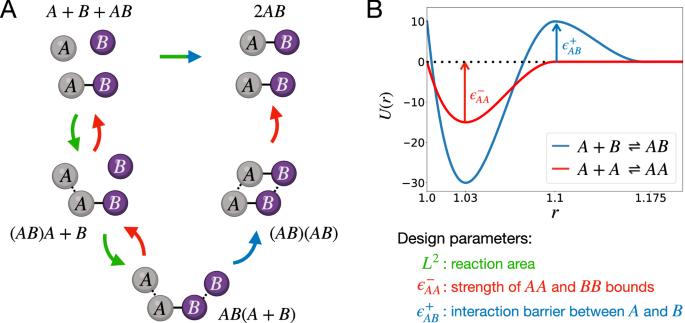最小自催化剂的设计原理、生长规律和竞争。
IF 5.9
2区 化学
Q1 CHEMISTRY, MULTIDISCIPLINARY
引用次数: 0
摘要
在没有酶、外部驱动力或巧妙的内部机制的情况下,要设计出指数级增长的简单自催化剂非常困难,这严重制约了在化学和物理系统中出现自然选择进化的设想。在这里,我们系统地分析了最简单、最通用的自催化剂所面临的这些困难:一种通过模板连接复制的二聚分子。我们的研究表明,尽管这种自催化剂很简单,但它可以实现指数级的自主增长。不过,我们也证明,有可能设计出比指数型自催化剂更简单的亚指数型自催化剂,它们在竞争共同资源时比指数型自催化剂更有优势。我们通过开发基于动力学势垒图的理论框架得出上述结论。除了对生命起源领域普遍接受的假设提出挑战之外,我们的研究结果还为在分子或胶体尺度上实现表现出自然选择形式的基本自催化剂提供了实验蓝图。本文章由计算机程序翻译,如有差异,请以英文原文为准。

Design principles, growth laws, and competition of minimal autocatalysts
The difficulty of designing simple autocatalysts that grow exponentially in the absence of enzymes, external drives or ingenious internal mechanisms severely constrains scenarios for the emergence of evolution by natural selection in chemical and physical systems. Here, we systematically analyze these difficulties in the simplest and most generic autocatalyst: a dimeric molecule that duplicates by templated ligation. We show that despite its simplicity, such an autocatalyst can achieve exponential growth autonomously. We also show, however, that it is possible to design as simple sub-exponential autocatalysts that have an advantage over exponential autocatalysts when competing for a common resource. We reach these conclusions by developing a theoretical framework based on kinetic barrier diagrams. Besides challenging commonly accepted assumptions in the field of the origin of life, our results provide a blueprint for the experimental realization of elementary autocatalysts exhibiting a form of natural selection, whether on a molecular or colloidal scale. Autocatalysis plays an important role in the origin of life and molecular evolution, however, designing simple autocatalysts that grow exponentially remains challenging. Here, the authors computationally design simple autocatalysts-- dimeric molecules that duplicate by templated ligation, --and show that these autocatalysts can achieve exponential growth autonomously.
求助全文
通过发布文献求助,成功后即可免费获取论文全文。
去求助
来源期刊

Communications Chemistry
Chemistry-General Chemistry
CiteScore
7.70
自引率
1.70%
发文量
146
审稿时长
13 weeks
期刊介绍:
Communications Chemistry is an open access journal from Nature Research publishing high-quality research, reviews and commentary in all areas of the chemical sciences. Research papers published by the journal represent significant advances bringing new chemical insight to a specialized area of research. We also aim to provide a community forum for issues of importance to all chemists, regardless of sub-discipline.
 求助内容:
求助内容: 应助结果提醒方式:
应助结果提醒方式:


